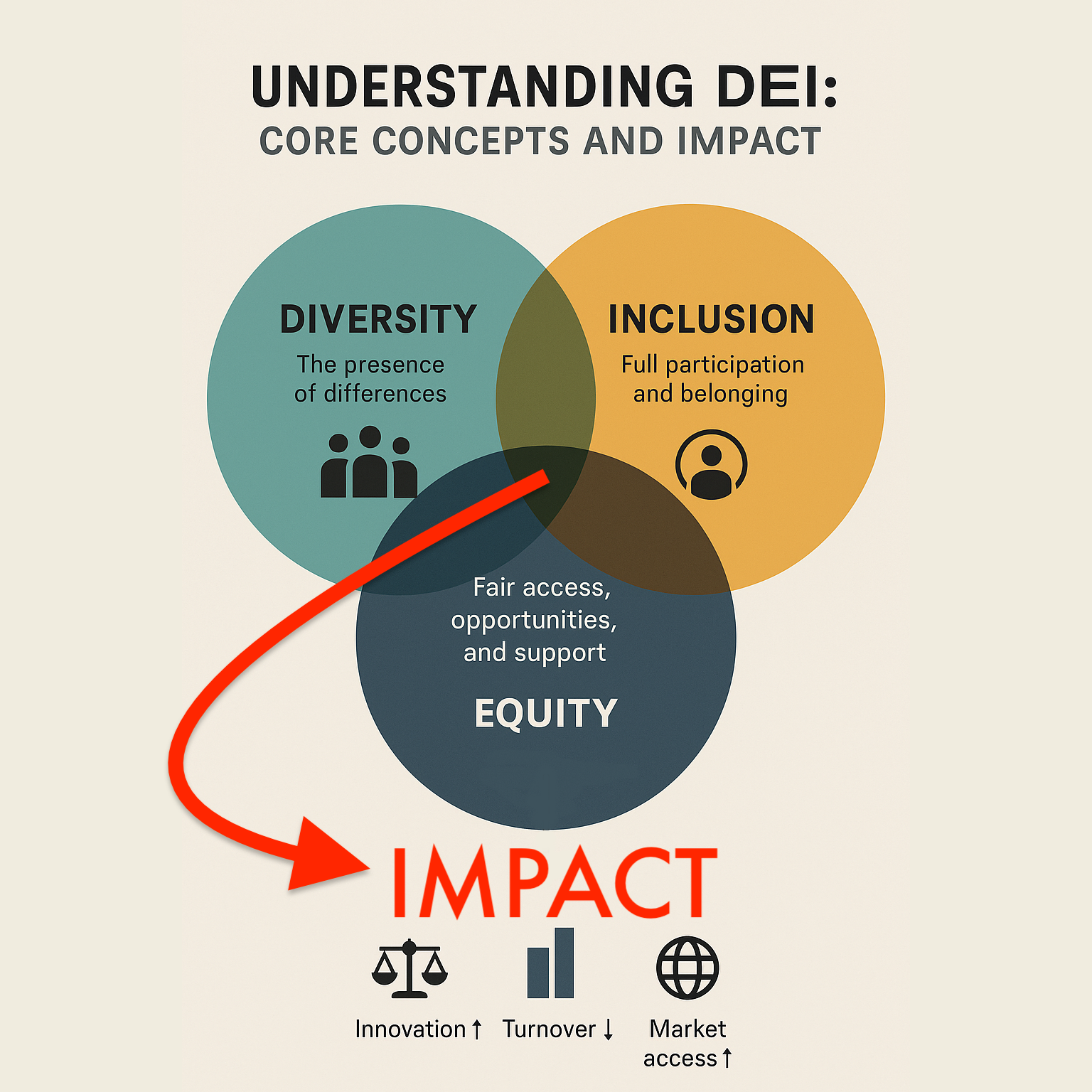The Foundation on Which We Stand
Authored by Jacob Brier (they/them), half full, llc Facilitator
Understanding the values and value behind the acronym that launched a thousand shifts: DEI
In both public and private sectors, the role of diversity, equity, and inclusion (DEI) in setting goals and shaping policy has been hotly debated. The current federal administration has taken the position that these values have no place in government or business. Yet much of the criticism aimed at DEI stems from misunderstanding — or misrepresenting — what these values truly mean and what their implementation seeks to achieve.
This blog is the first in a multi-part series aimed at correcting those misunderstandings and presenting a clear, grounded understanding of what diversity, equity, and inclusion look like in practice, and why they matter. Here, we define the foundational concepts. In the next post, we’ll explore how well-executed DEI policies contribute directly to business performance and organizational health.
What It Means
When accurately defined and thoughtfully implemented, the values behind DEI are not controversial — they are common sense. Mischaracterizing DEI as a threat to merit or efficiency weakens serious discourse. Understanding what each term means in a business context is a necessary first step.
Diversity
Merriam-Webster defines diversity as "the condition of having or being composed of differing elements," especially in reference to people of different races, cultures, or identities.
Jacob Brier (they/them), half full, llc Facilitator
In the workplace, diversity refers to the collective makeup of employees — the presence of a range of experiences, perspectives, and backgrounds. It’s important to note that diversity applies to groups, not individuals. A person isn’t a "diverse employee." An individual hire may contribute to creating a more diverse team.
Inclusion
Inclusion is defined as "the act or practice of including and accommodating people who have historically been excluded," according to Merriam-Webster. In practical terms, it’s about how integrated different identities are within an organization’s practices, communications, and policies.
A good example of inclusive policy might be translating employee handbooks into multiple languages in a multilingual workplace. Inclusion ensures people are not just present but valued and empowered.
Equity
Equity involves "fairness or justice in the way people are treated." Unlike equality — which treats everyone the same — equity recognizes that people have different needs and circumstances. In business, equity ensures that all employees have access to the tools and opportunities that enable them to succeed. It’s about making support meaningful to everyone.
Understanding Related Terms
Words like belonging, justice, accessibility, allyship, and culture are often included in the DEI vocabulary. Each contributes to creating work environments where employees feel respected and supported. Unfortunately, these terms are sometimes manipulated to discredit DEI efforts by portraying them as overreaching or vague. In truth, these values reflect a deliberate commitment to fairness and engagement.
Here is an example of one of these topics in a workplace setting: Imagine sharing an idea in a meeting, and it goes unnoticed. Then, a few minutes later, somebody else restates your idea and they are praised for it. Fortunately for you, another meeting participant then calls attention to your prior statement, bringing you the positive recognition you earned. That person who spoke up is your ally. Taking opportunities for allyship is particularly impactful for underrepresented coworkers, who can be more easily overlooked.
Clarifying Merit
The term "merit" is often invoked in debates about DEI, sometimes as if it were in opposition to inclusive hiring practices. Merriam-Webster defines merit as "qualities or actions regarded as indicating what a person deserves to receive."
In business, merit typically encompasses education, experience, job performance, and sometimes intangible qualities like work ethic. It is a mistake to suggest that hiring for diversity undermines merit. On the contrary, failing to cast a wide recruiting net could mean overlooking highly qualified candidates who bring valuable perspectives.
Related Reading: Five Leadership Truths to Create an Inspiring Workplace
Walking the Walk
Understanding the definitions is just the beginning. The real challenge lies in weaving DEI values into the fabric of organizational culture. This doesn’t mean token gestures or symbolic statements — it means policies and practices that enable people to show up fully and contribute meaningfully.
Hiring across diverse backgrounds isn’t a favor to the underrepresented; it’s an investment in dynamism and adaptability. Just as investors diversify their portfolios to reduce risk and increase stability, organizations benefit from a diversified workforce that brings a broad range of insights and experiences.
Similarly, inclusive environments don’t just make people feel good — they enhance performance. Employees who feel safe, respected, and seen are more productive, more loyal, and more likely to innovate.
The Business Case
Adopting good policy and practice is a strategic imperative. When implemented with clarity and purpose, DEI practices enable organizations to access a broader talent pool, foster innovation, and navigate complex markets with greater agility.
These are not ideological ideals; they are practical responses to the demands of the modern workforce and global marketplace.
For a recent highlight of the broad market appeal and success of these practices, look at Levi Strauss & Co. The US-based global apparel company, with more than a half dozen internationally successful brands, recently faced a challenge to its DEI programs. With the encouragement of their executive team, 99% of Levi Strauss shareholders voted against the proposal. This vote affirmed the view that the continued financial success Levi Strauss achieves is a result of, and not despite, its diverse and inclusive workplace culture.
In the second part of this series, we’ll look more closely at evidence and hard data to illustrate the business impact of getting DEI right.
Rejecting these values is not a serious option for any organization that seeks growth and success. The future belongs to those who build it — together.


